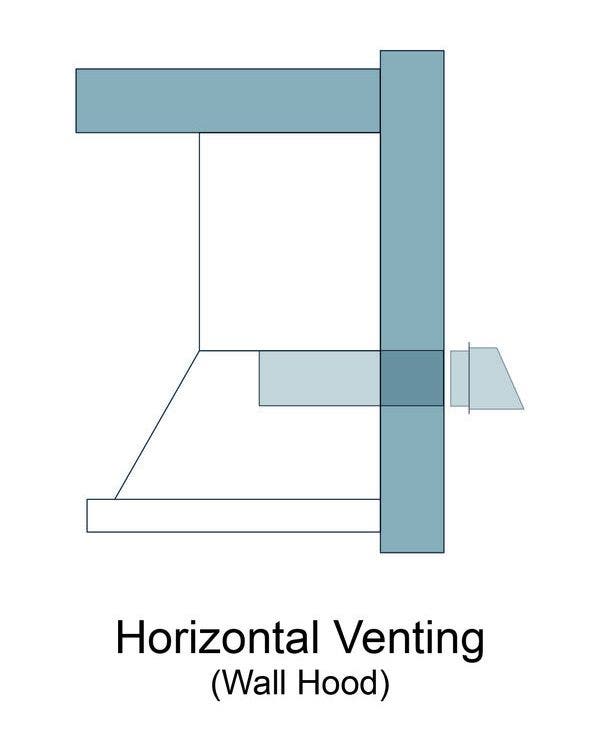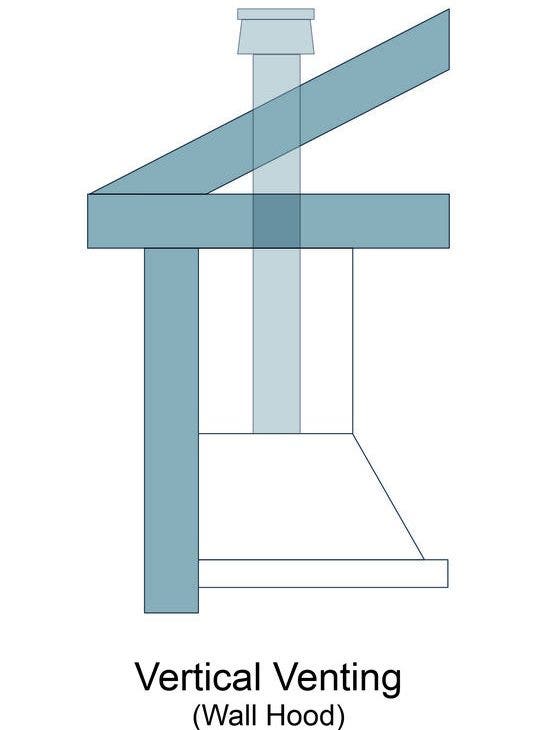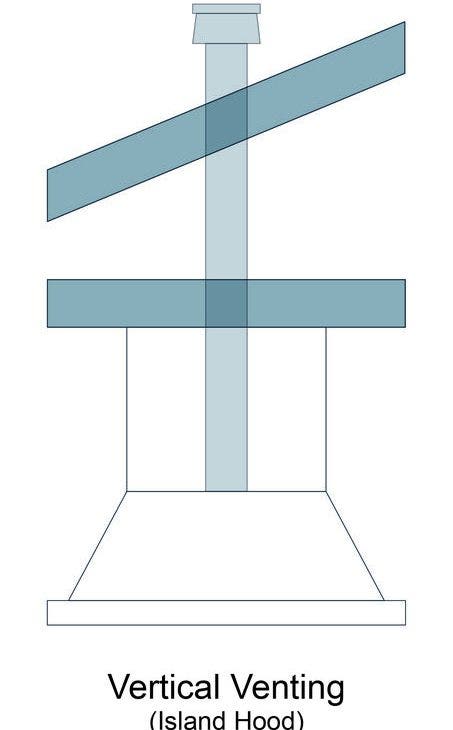Can I Vent Range Out Wall Up Through Roof


I of the nigh of import choices you lot'll brand when it comes to your new range hood is whether or not it will vent outside. Ducting your vent hood to the exterior is the all-time option to keep your air clean and salubrious.
But, depending on the design of your kitchen, you may be limited to where you can install the ductwork.
Before you install ductwork, be sure yous have the room to run it from your range hood to the outside. If yous take the space, yous have a few different venting options.
Range Hood Venting Options
The ducting may run horizontally or vertically depending on your type of hood. Island hoods must vent through the ceiling, while wall hoods can vent through the wall or ceiling.
Installing Range Hood with Horizontal Duct
You lot have two options to vent your wall hood horizontally.

Installing Range Hood with Vertical Duct
You can also vent your wall hood through the ceiling, as in the diagram beneath.

Unlike wall hoods, island hoods can but vent through the ceiling.

Yous may be wondering: which venting selection is the best?
The best ducting option for your range hood volition depend on your kitchen blueprint. But there are several things you can do to maximize the efficiency of your range hood duct.
Best Practices When Installing Range Hood Ductwork
ane. Do not stop the vent organisation into an attic, or some other enclosed area.
If you follow any tip in this list, follow this i. It is vital that you vent your hood outside your home, through the ceiling or wall.
It's not healthy for fume, cooking exhaust, humidity, and contaminants to build up in your attic. Instead, run the duct all the way to the exterior. This way, you lot'll go rid of the smoke and cooking exhaust for good.
The all-time pick is to vent vertically through the roof if possible, since hot air rises. But this is not required. Vent through a side wall if yous cannot vent directly higher up your hood.
To have a smooth installation, find a great contractor to install your ductwork.
2. Do not utilise more than than 2 elbows in your ductwork. The fewer elbows, the better.
Each elbow adds some resistance to your duct organization, which makes information technology harder for air to make information technology to the outside.
A couple of elbows are OK; you might demand them only to navigate through your walls. Simply don't employ more than ii to keep your hood running as efficiently equally possible.
When calculation elbows to your duct, keep the following in mind:
- For each elbow in your duct, reduce the total length of your duct run by 5'. For example, a 30' straight run is about equivalent to a 20' run with two elbows.
- When installing your duct, include at to the lowest degree 18″ of direct run before adding an elbow.
- Make sure there is at least 24″ of directly duct between each elbow.
three. Install your ductwork in the shortest unobstructed path to the outside of your habitation.
When possible, orient your ductwork so that yous use the shortest run possible with the fewest elbows. This fashion, the unwanted air encounters the least corporeality of resistance and vents out of your home with ease.
Ignoring aesthetics, the shortest and straightest run of ductwork is the all-time for the power, efficiency, and longevity of your vent hood.
Do not employ more than than 30' of ductwork. The longer your duct, the more resistance information technology has.
If your duct is longer than 30', the air will really struggle to go far to the exterior, even with a powerful range hood.
4. Apply rigid galvanized steel or metal HVAC ducting only. Do non use plastic flexible duct.
A range hood should final you 10+ years, simply flex duct merely won't concord up that long. Rigid duct is much more durable. It'due south your best pick.
Rigid duct systems will likewise meet less air resistance than flex duct systems, so all the greasy kitchen air volition move smoothly to the outside.
Brand sure that yous employ the appropriate sized duct to keep your duct system efficient. Duct size depends on the CFM of your range hood.
For example, if you lot have a 900 CFM hood, do not reduce the diameter of your duct below 8". See the graphic below.
Once you've installed the appropriate duct, seal information technology to your hood using aluminum tape.
5. Seal the cease of your duct run with a wall or roof cap.
A cap keeps dirt and debris out of your duct. It likewise prevents backdrafting, which is when outside air moves into your duct.
And so, use caulking to seal exterior openings around the cap.
This keeps the cap secure and prevents greasy kitchen air from leaking out the edges of your duct organisation.
What is a ducted range hood?
A ducted range hood moves air through a duct to the exterior of the home. A ducted hood tin can be installed through your cabinetry, ceiling, or straight through the wall behind the hood. Ducted range hoods are common in commercial kitchens, homes with gas stovetops, or higher-finish homes. They are almost always the preferred pick for cooking ventilation.
That covers some of the nearly important things to consider when installing ducted range hoods. At present, nosotros'll talk over ductless hoods.
How do ductless range hoods piece of work?
Ductless range hoods do not vent to the exterior of the home like ducted hoods. Since they cannot expel the air they take in, these range hoods filter the air and then recirculate information technology back into the kitchen. The air is then filtered through charcoal or activated carbon, which removes contaminants before it recirculates back into the kitchen.
The charcoal filters are located within the range hood on the blower. They cannot be cleaned, and so they must be replaced after about 150 hours of cooking, depending on your cooking habits. If you cook intensely with a lot of grease and smoke, yous may need to replace them more often.
Generally, the charcoal filters can be expensive, but here at Proline, our ductless models work effectively with inexpensive, premium quality, and easy-to-replace charcoal filters.
Which is better, a ducted or ductless range hood?
Ducted range hoods are almost e'er preferable over ductless range hoods, since they vent the kitchen air to the exterior of your dwelling house. Ducted hoods are much more powerful and efficient than ductless hoods. They volition continue your kitchen air clean and fresh for years to come up.
Some homeowners who alive in an apartment or can't install ductwork in their home will use a ductless hood.
What is the divergence between ducted and convertible range hoods?
The main difference between ducted and convertible range hoods is that convertible hoods can convert from ducted to ductless. Convertible hoods come with a recirculating kit or charcoal filters to convert the hood to ductless. A ducted hood, on the other hand, cannot be installed as ductless.
Ducted vs Ductless Range Hoods
While a ducted range hood is the first choice for near chefs and homeowners, both ducted and ductless hoods have their pros and cons.
For a more in-depth comparison of ducted vs ductless range hoods, check out this consummate article.
Ducted Range Hood Pros
- Completely removes smoke and fumes from the kitchen
A ducted range hood pulls the smoke, grease, and unwanted contaminants through ductwork and outside your home, compared to a ductless hood which merely recirculates the air back into your kitchen.
- Keeps your walls, cabinets, and ceilings grease-gratuitous
With all the dirt and crud completely gone, your cabinets and the surrounding area will stay clean for much longer than they would with a ductless hood.
- Eliminates strong odors in the kitchen
Ducted hoods besides remove strong odors from your kitchen, which is especially great if you lot cook Asian nutrient or fried food.
- Does not include charcoal filters – no need to supplant them!
Hoods that duct to the outside use stainless steel baffle filters or mesh filters which are dishwasher-safe. This is cost effective in the long run because you don't have to consistently spend money on charcoal filters.
- Keeps backlog heat from your cooking out of the abode
While cooking, the estrus generated from the burners or grill tin can warm up the kitchen fast. Just a ducted range hood can send this hot air outside your domicile in no fourth dimension. With a ducted hood, you tin can cook comfortably and take an enjoyable experience in the kitchen.
- Uniform with inline or external blowers which are much less noisy than local blowers
Inline blowers are no different than local blowers in terms of efficiency, just they are placed inside your ductwork –further away from your kitchen. This drastically reduces the noise level or sones of your vent hood.
Ducted Range Hood Cons
- Can't exist installed in every kitchen
You may not accept the room for ductwork, which means you will either have to make room (this can be expensive and time intensive) or invest in a ductless hood.
- Ductwork is an added cost
Since you need a professional to install ductwork, you lot will have to factor its installation into your budget.
Ductless Range Hood Pros
- Tin get nigh anywhere
You have much more liberty in where you locate your ductless range hood. You are not bound by where ducting tin can go or already exists.
- Like shooting fish in a barrel to alter the layout of your kitchen
When remodeling, a ductless range hood can exist reinstalled at some other location. Plus if you're renting, you tin take information technology with you when you movement out.
- Saves money
Since y'all don't need to install ducting, yous will salve immense fourth dimension and effort.
- Uses less energy
Ductless hoods don't require the power to motility air through ducting to the outdoors.
- Repose
Although ductless hoods are non as powerful every bit ducted hoods, they are incredibly tranquillity. Believe it or non, the low CFM comes with an advantage – noise level – especially with an efficient blower or blowers.
Ductless Range Hood Cons
- Not as efficient equally a ducted range hood
The number one disadvantage of a ductless range hood is that it is incapable of removing every bit many air contaminants as a range hood that vents exterior. Unlike ducted hoods, ductless hoods don't remove heat and moisture – they just recirculate it back into your abode. This means your kitchen may get quite humid while cooking – and smells may linger for a longer period of time.
- Charcoal filters are inefficient
Charcoal filters cannot filter out smoke and grease fully which could event in cooking odors and grease build up on kitchen surfaces.
- Charcoal filters require replacement
Charcoal filters need to be replaced every three to six months, or afterward most 120 to 150 hours of cooking.
If you are contemplating installing a range hood that will vent outside, make sure you carefully consider the pros and cons. Even though ducted range hoods are preferred, they might not always be the right choice.
Some homeowners may be fine with a ductless range hood if they live in an flat, do not cook very often, savor depression-intensity cooking, or fix cuisine with fewer strong odors, such as vegetarian.
What type of duct is best for venting a range hood?
Rigid duct is without a doubt the best option for venting your range hood. Rigid duct is higher quality than flex duct and is made of much more durable materials.
For more information on choosing the right type of duct for your range hood, check out this article.
Do range hoods accept to be vented outside?
No; range hoods without a duct, or ductless range hoods, can recirculate air back into your kitchen. However, to clean your kitchen air nigh efficiently, purchase a ducted range hood. Rather than relocate the cooking exhaust, it volition evacuate it from your home entirely. This drastically improves your indoor air quality and is beneficial for your health and condom in the long-term.
How far tin yous vent a range hood?
Your range hood duct should not exceed thirty' for a direct run, 25' for a run with i elbow, and 20' for a run with two elbows. The shorter the duct, the better. If your ductwork is too long, your kitchen air may not achieve the outside. Backdrafting tin can also occur, where air stays inside your duct, flows back through your hood, and into your cooking space.
How far should a range hood stick out?
A range hood should stick out at a minimum half the length of your kitchen range and typically does not extend past its full length.
Should I insulate my vent hood duct?
Yous can insulate your vent hood duct, but it'south not required. Insulating your duct will reduce the dissonance of your blower, if it'south inline with the ductwork. It'll also assist forestall smoke and greasy air from escaping into your joists and attic.
Learn more in this complete article.
Is it possible to change a range hood top duct to a rear duct if information technology'southward a top duct only?
If you have an isle range hood, this is not possible. Island range hoods can only vent through the ceiling. But, some wall and under cabinet range hoods take rotatable blowers. This means that you can rotate the blower to vent horizontally or vertically depending on your kitchen setup.
If your ductwork is already installed, it's not recommended to change your range hood from a top duct to a rear duct. This can be an expensive and time-consuming projection that requires a professional contractor.
Tin can a kitchen operate if half the hood vent system is not running?
It depends on what part of the hood is not running. If the lights are not working, this is often not a huge problem. Nevertheless, if the motor, touch console, or circuit lath is broken, you will demand to call your manufacturer for a replacement. Your hood won't run efficiently without these parts fully intact.
How to Install a Range Hood Vent Through the Wall
For a complete walkthrough of the installation, cheque out this article.
How to Install a Range Hood Vent Through the Ceiling
Check out the total step-by-step guide here.
We hope this information on range hood venting options every bit well every bit ducted and ductless range hoods has been helpful for you. Cheers for reading!
Related Articles
Do ductless hoods actually work?
How to Find a Contractor to Install My Vent Hood
Is it OK to vent a range hood into the attic?
What are ducted range hoods?
Ducted range hoods are hoods that vent outside your dwelling. They are fitted with a duct that carries air contaminants through pipes to the exterior of the home. They tin go through your cabinetry, ceiling, or straight through the wall behind the hood. The vent exhausts outside either to an outside wall or the rooftop.
Ducted range hoods are common in commercial kitchens, homes with gas stovetops, or college-stop homes. They are nearly always the preferred pick for cooking ventilation.
How do ductless range hoods work?
Ductless range hoods exercise not vent to the exterior of the home like ducted hoods. Since they cannot expel the air they take in, these range hoods filter the air and and so recirculate it dorsum into the kitchen. The air is so filtered through charcoal or activated carbon, which removes contaminants before it recirculates back into the kitchen.
What blazon of duct is all-time for venting a range hood?
Rigid duct is without a doubt the best option for venting your range hood. Rigid duct is higher quality than flex duct and is made of much more durable materials.
Exercise range hoods have to exist vented outside?
No; range hoods without a duct, or ductless range hoods, can recirculate air back into your kitchen. Yet, to clean your kitchen air most efficiently, purchase a ducted range hood. Rather than relocate the cooking exhaust, it will evacuate it from your home entirely. This drastically improves your indoor air quality and is benign for your health and safety in the long-term.
How far tin can you vent a range hood?
Your range hood duct should non exceed 30' for a straight run, 25' for a run with one elbow, and twenty' for a run with 2 elbows. The shorter the duct, the ameliorate. If your ductwork is too long, your kitchen air may non reach the outside. Backdrafting tin can as well occur, where air stays inside your duct, flows back through your hood, and into your cooking space.
How far should a range hood stick out?
A range hood should stick out at a minimum half the length of your kitchen range and typically does not extend past its total length.
Is it possible to change a range hood top duct to a rear duct if it's a superlative duct only?
If you have an island range hood, this is not possible. Island range hoods can just vent through the ceiling. But, some wall and nether cabinet range hoods have rotatable blowers. This means that you can rotate the blower to vent horizontally or vertically depending on your kitchen setup.
If your ductwork is already installed, it's not recommended to change your range hood from a top duct to a rear duct. This tin can exist an expensive and time-consuming project that requires a professional contractor.
Tin a kitchen operate if half the hood vent system is not running?
Information technology depends on what part of the hood is not running. If the lights are non working, this is oft non a huge problem. All the same, if the motor, touch console, or circuit board is cleaved, you will demand to call your manufacturer for a replacement. Your hood won't run efficiently without these parts fully intact.
Which is better, a ducted or ductless range hood?
Ducted range hoods are almost e'er preferable over ductless range hoods, since they vent the kitchen air to the outside of your home. Ducted hoods are much more powerful and efficient than ductless hoods. They will keep your kitchen air clean and fresh for years to come.
Some homeowners who alive in an apartment or can't install ductwork in their home volition utilise a ductless hood.
What is the difference betwixt ducted and convertible range hoods?
The main deviation between ducted and convertible range hoods is that convertible hoods tin can convert from ducted to ductless. Convertible hoods come with a recirculating kit or charcoal filters to catechumen the hood to ductless. A ducted hood, on the other hand, cannot be installed equally ductless.
Should I insulate my vent hood duct?
Yous tin insulate your vent hood duct, but it'southward not required. Insulating your duct will reduce the noise of your blower, if it's inline with the ductwork. Information technology'll as well assist prevent smoke and greasy air from escaping into your joists and attic.
Learn more in this consummate article.

Source: https://www.prolinerangehoods.com/blog/range-hoods-that-vent-outside/#:~:text=The%20best%20option%20is%20to,contractor%20to%20install%20your%20ductwork.

0 Response to "Can I Vent Range Out Wall Up Through Roof"
Post a Comment